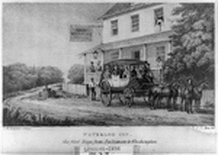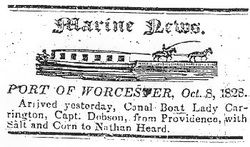Transportation
 Library of Congress
Library of Congress
The nature of transportation is constantly evolving and shifting to accommodate new needs, link expanding economic markets, and reflect new technologies. Explore the Library of Congress' "Technology and Transportation" section on the American Treasures page of their website (http://www.loc.gov/exhibits/treasures/tr22c.html#transp).
Questions to Consider:
What was the condition of roads in the 1800s? Were does the term "turnpike" come from? How were roads built and maintained? How were canals and railroads built? Who did most of the labor? How did canals and railroads effect each other?
Primary sources to compare and contrast:
Questions to Consider:
What was the condition of roads in the 1800s? Were does the term "turnpike" come from? How were roads built and maintained? How were canals and railroads built? Who did most of the labor? How did canals and railroads effect each other?
Primary sources to compare and contrast:

- Pope Automobiles http://library.duke.edu/digitalcollections/eaa_A0026/
- Railroads:
- Denver and Rio Grande Railroad http://library.duke.edu/digitalcollections/eaa_A0599/
- B&O RR
http://library.duke.edu/digitalcollections/eaa_A0572/ - Taking Up the Mail Bag http://www.loc.gov/item/00564551
Mitchell's new traveller's guide through the United States, showing the rail roads, canals, stage roads &c. with distances from place to place, 1853
http://www.loc.gov/resource/g3700.rr000230/
Turnpikes, Canals and Railroads in the United States, 1835
The Newberry Library website offers this wonderful activity:
"A map published for travelers in the United States in 1835 provides the background for lessons examining the nature and extent of transportation systems at the height of the canal era. The lessons build transportation map reading skills and examine the role of transportation systems in the development and settlement of the country's original "West"-the lands between the Appalachian Mountains and the Mississippi River."
http://publications.newberry.org/k12maps/module_10/
